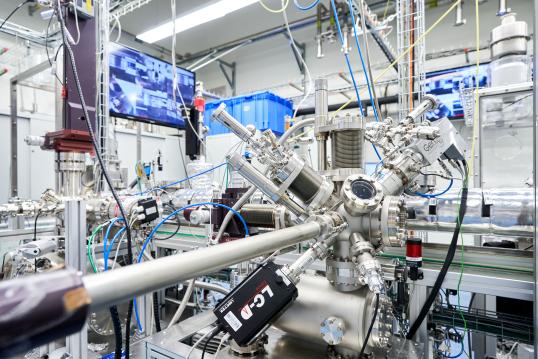The radioactive chemical elements that follow actinium in the Periodic Table form the actinide series. These elements are the backbone of nuclear fission technologies for electricity supply, with important applications in other strategic fields, from water management to space exploration and human health.
Actinide research
As the atomic number increases in the series from 90 to 103, added electrons enter the highly anisotropic 5f shell. This shell is characterized by a radial wave function extending relatively far from the nucleus, so that 5f electrons can either form band states or retain a localized behavior. With 5f-electrons poised at the edge between non-bonding and bonding configurations, actinide elements are prone to lattice instabilities and plutonium, which goes through six allotropic forms in heating to its melting point, is a fascinating example of how complex their structural behavior can be.
Equally intricate are the electronic properties of actinides. From one side, the intra-atomic electron correlation is strong, for the large electric charge of the nucleus pulls the electrons close to each other, favoring the formation of a magnetic moment. On the other hand, quantum fluctuations of electronic and magnetic degrees of freedom can be so strong that the magnetism melts, favoring new classes of materials behavior and emergent properties around the points of instability. Other sources of complexity are the hybridization between 5f and conduction-electron states, which may give rise to a variety of different phenomena, from unconventional superconductivity to topologically protected states, and the interplay of spin and unquenched orbital degrees of freedom, which can result in exotic phase transitions driven by hidden order parameters.
Besides fundamental science interests, achieving a deep understanding of actinides is vital to ensuring a safe deployment of civil nuclear technologies. However, only a few facilities are available worldwide where actinide materials can be safely investigated. Among these, a prominent position is occupied by the laboratories operated by the Joint Research Centre (JRC) of the European Commission. In its establishment located near the charming German town of Karlsruhe (one of the sites of the JRC’s Directorate for Nuclear Safety and Security), the JRC operates state-of-the-art instruments for measuring spectroscopic, thermodynamic, magnetic, and electrical transport properties of radioactive materials, together with specialised facilities for the preparation of high-quality samples, from single crystals to organometallic complexes and epitaxial thin films. Available techniques include, among others, magic-angle-spinning nuclear magnetic resonance, photoemission and Mössbauer spectroscopy, SQUID magnetometry, Seebeck- and Hall-effect probes. By exploring materials properties in a wide range of temperature, pressure, and magnetic field, studies performed at the JRC are helping in bringing the actinide knowledge to a “material-by-design” level.
Safety precautions at Universities in Europe have almost excluded the possibility of working beyond uranium in the periodic table; with JRC’s unique facilities being opened to the academic community on the basis of peer-reviewed proposals, Europe’s researchers can still be at the cutting edge of this vital field.
Open Access
PAMEC is an ensemble of state-of-the-art installations designed for basic research on behaviour and properties of actinide materials under extreme conditions of temperature, pressure, external magnetic field and chemical environment. The facility includes the following devices:
| Activity |
Facility (GB= sample in glove box) (sc= sample in safe container)
|
Remarks |
|---|---|---|
| Sample Preparation |
Arc Melting (GB) Solid-solid reaction (GB) Metal Flux (GB) Furnace (GB) Sputter deposition (GB) Solution chemistry (GB) |
Polycrystalline Polycrystalline Single crystal Annealing Thin films Complexes |
| Sample Characterization |
Powder X-ray diffraction (GB) Powder X-ray diffraction High-temperature (GB) Single-crystal XRD; 4-circles diffractometer (SC) Single-crystal XRD; Laue diffractometer (SC) |
300-1600K |
|
Surface Science techniques |
Film deposition by DC sputtering Photoelectron spectroscopy (UPS, XPS, AES) (GB) LEED HREELS (GB) TPD |
Oxide, nitride, intermetallic films in different condition of deposition |
| Sample Encapsulation |
U-Th glove box Transuranics glove box Press glove box Decontamination glove box |
Specific for each measurement |
| Physical Properties Measurements |
AC and DC Magnetometry (MPMS3) (SC) Specific heat (PPMS9 and PPMS14) (SC) Electrical resistivity (PPMS9 and PPMS14) (SC) Electrical resistivity High-Pressure (SC) Thermo-power (SC) 237Np Mössbauer spectroscopy (SC)
Solid-state Magic Angle Spinning NMR (GB) Static NMR (SC) |
2K<T<300K -7T<B<7T
0.35K<T<300K 0<B<14T
0.35K<T<300K 0<B<14T
0<P<20Gpa 1.5K<T<300K
1.5K<T<150K
300K 2K<T<300K |
Previous open access calls can be visited here
Laboratory photos
Scientific equipment for photoemission, atomic force microscopy, and electron scattering measurements at the PAMEC laboratory © EU, 2021
You can view additional images of the Properties of Actinide Materials under Extreme Conditions (PAMEC) at the JRC Digital Media Hub.


